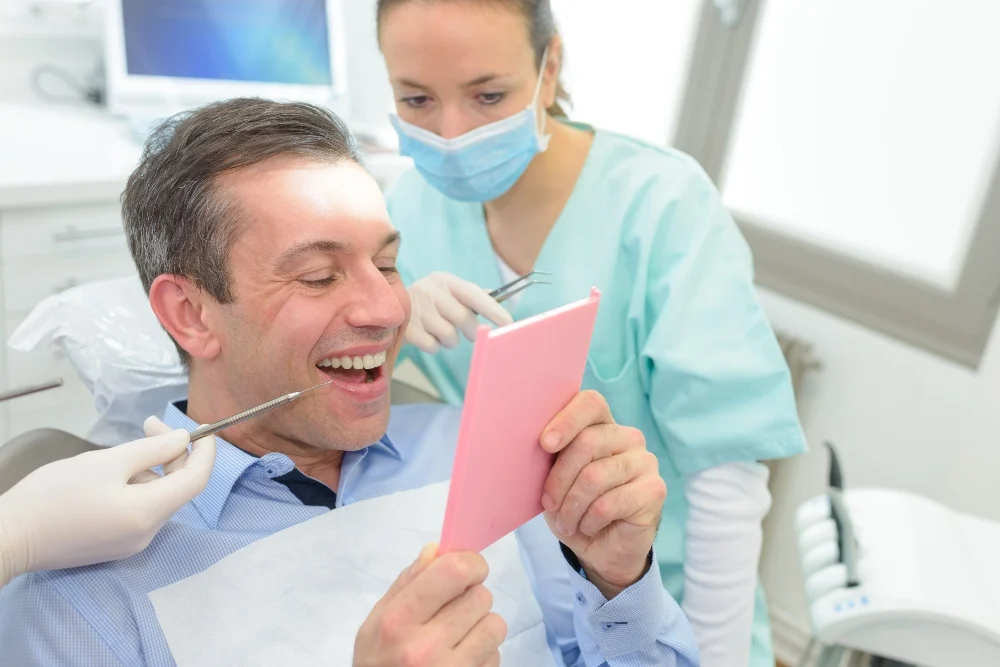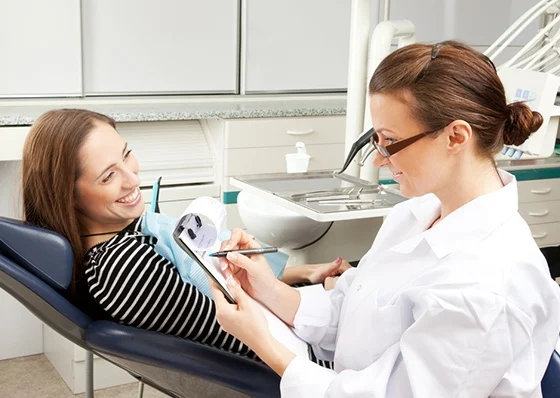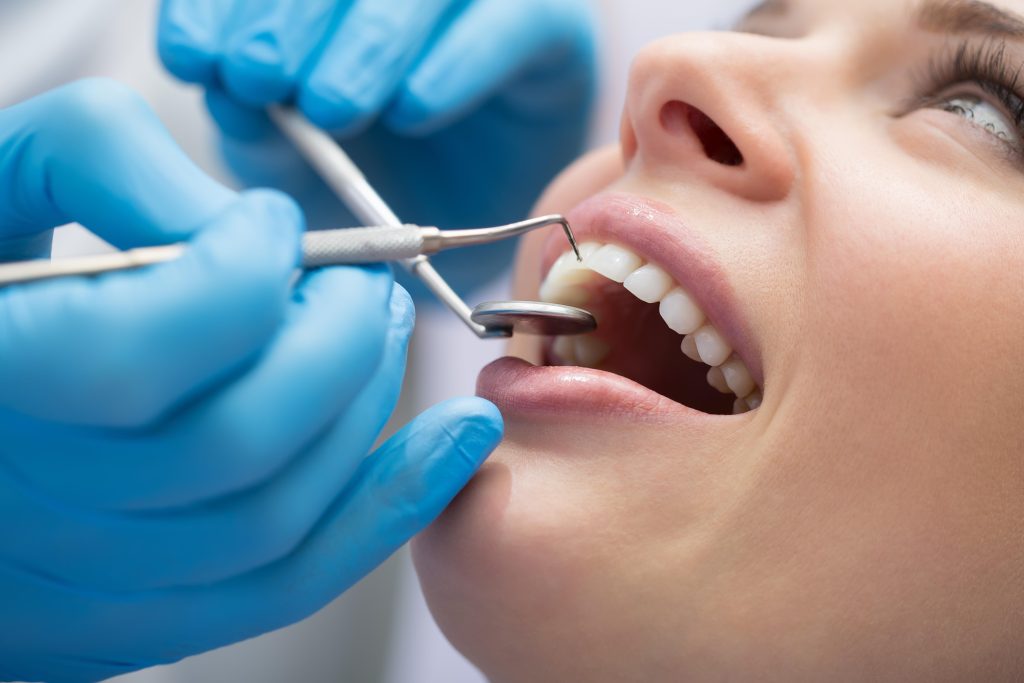Tips to get patients in faster with a New Patient Exam with the assistant and dentist
This blog is about the new patient exam with the dentist and the assistant.
New patients will likely be scheduled for their first appointment as either:
1) a hygiene patient in the hygiene chair.
2) an emergency appointment to focus on a specific problem with an assistant or dentist.
3) (the focus of this blog post) doing a comprehensive or limited exam with the dentist and the assistant.
New patient exams with the dentist and the assistant and when to schedule these and how to do them.
If a new patient doesn’t have a dental emergency, but they want to become an established
patient in the practice, you want to get them in as soon as possible.
Sometimes the hygiene schedules may be full, and even when a hygiene opening is available- we may not know if the patient needs a prophy or periodontal therapy until we see the patient.
And the patient may want a cleaning, but we may find they also need fillings. You don’t know what the patient really need until we see the patient and do an exam.

So having a visit with the dentist and the assistant can be a great first visit for the new patient. This gives the patient a chance to get to know the office and for you to get to know the patient.
It also helps the patient get in sooner if the hygiene schedule is full. And they get to meet everyone and you can focus on the patient’s needs and concerns and make the best plan possible.
Also, the initial visit usually requires a lot of records if the patient hasn’t been there before and it takes extra time to get the X-rays, medical history and dental charting. And when we get this information, sometimes the hygienist wouldn’t have time to do a cleaning the first day anyway, even if the hygienist was seeing the patient.
There’s just not enough time to get all of the records and start treatment.
Getting records and starting any necessary treatment plans

Having that new patient visit with the assistant and the dentist really helps the hygienist to get a lot of these needed records.
The new patient exam with the assistant and dentist can be an opportunity to create a
treatment plan for restorative and any periodontal needs and help make plans for both.
You can use the opportunity to start answering questions about insurance benefits before the treatment starts, and then we can start the treatment.
Whatever we find is most appropriate- we can start there- whether it’s we need to prepare records for a hygiene visit, or plan for a restorative need, we can address it at the exam with the dentist and assistant.
If there’s a need for oral surgery or endo or something urgent, we can do that.
So the thing is, we need to communicate with the patient ahead of time, the reason for the new patient exam with the dentist, and we can tell them “this is an opportunity for you to get to know us and for us to get to know you. We’ll get all the records we’ll need for later, and we can customise a plan based on your needs.”
If you have urgent care, restorative care, hygiene area care that’s needed, we can make a treatment plan, review the benefits, and get you established and do things in the best possible way.
How to schedule these new patient comprehensive exams
Typically, a lot of these records will be done by the assistant.
So can create space in an assistant column to see these patients.
You can save blocks on the schedule for it or you can just have an extra column and chair for
new patient exam with the assistant and dentist..

You can sometimes call it a ghost column, but the second assistant can do the records, a rover assistant can be a good person to be available to help with these patients, and it’ll take less time for the dentist to check these patients once the records and treatment plans are in place.
And then once the patient treatment plan has been made, there’s always an opportunity to move that patient into the hygiene column or to the restorative column if there is an opening that day.
You may want to look at scheduling these first thing in the morning or right after lunch so that you’re always on time. Plus you have more time after the records are done to look for openings the same day in the doctor or hygiene chairs.
This appointment could be done at other times during the day, just depending on when the chair and the assistant is available.
What to do at these appointments?
For these appointments you should:
- get the records that you need related to the chief concerns of the patient
- make the treatment plan
- start to review benefits.
For your records, you will want to get certain radiographs, like a panorex and bite wing xray if you don’t already have that, you could also do intraoral photos. They are a big plus. It’s very helpful for the patients to see what’s going on by looking at the photos. A picture is a thousand words.
And often there’s not enough time in the hygiene chair to do photos with the cleaning.
So this is a good opportunity for patient education to do the intraoral pictures, of course, update the medical history, update the charting for any dental findings, existing findings, and then record the chief complaint.
Why is the patient there today? Chart any current needs, any issues that we see or other treatment needs and make a treatment plan.
The treatment plan can be as simple as writing it out in the notes in the computer. It can also be more formalized in the practice management software by grouping certain codes into specific treatment plan options.
By making formalized treatment plans, you can even prioritize these treatment plans by stages, and this gives good information for your staff to help do a benefits check.
Whatever system you use to check benefits, you will have all the treatment information needed now to research and answer the questions for the patient: what does it cost? And so if it takes extra time to do that, you can decide if you want to start treatment now or if you want to do a second consultation to come back and review what you learn about the benefits available for this treatment.

Once the patient’s ready to proceed, it’s just a matter of scheduling that treatment, whether it’s something that can be done that day in the hygiene or the dental column, or if it’s something that can be scheduled based on the urgency in either of both of those columns at another date.
Now the patient’s established.
And we’ve really taken an opportunity for the patient to get to know us, us to get to know them, give them things to think about as far as concerns they may not have been aware of, and then to help to prioritize what’s the next step.
Setting the fee for a new patient exam
You can, of course, set the appropriate fee for a new patient exam based on what was done.
It may involve X-ray charges. It may involve a comprehensive exam if periodontal probing was done.
It may involve a limited exam if it was treatment planning without periodontal probing, and the patient can return for or periodontal probing later with the hygienist if it wasn’t done at that initial visit.
So the new patient exam with the dentists and assistant can be a great opportunity for the patient to be seen by the dentist for a sooner visit than on the hygiene schedule and to delegate a lot of the things for record gathering that the hygienist or dentist would have to do to be delegated to the assistant.


Профессиональный сервисный центр по ремонту Apple iPhone в Москве.
Мы предлагаем: ремонт айфонов в москве недорого
Наши мастера оперативно устранят неисправности вашего устройства в сервисе или с выездом на дом!
prometrium where to buy – clomid 50mg pill fertomid price
Профессиональный сервисный центр по ремонту сотовых телефонов в Москве.
Мы предлагаем: ремонт ноутбуков смартфонов
Наши мастера оперативно устранят неисправности вашего устройства в сервисе или с выездом на дом!
Профессиональный сервисный центр по ремонту Apple iPhone в Москве.
Мы предлагаем: сервисный центр iphone москва
Наши мастера оперативно устранят неисправности вашего устройства в сервисе или с выездом на дом!
Сервисный центр предлагает ремонт treelogic brevis 712dc 3g цены ремонт treelogic brevis 712dc 3g цены
Сервисный центр предлагает ремонт бесперебойника uniel адреса срочный ремонт бесперебойников uniel
order alendronate 70mg online cheap – pilex over the counter provera 5mg ca
Сервисный центр предлагает ремонт бесперебойников lestar недорого ремонт бесперебойников lestar на дому
buy aygestin 5mg pills – lumigan without prescription purchase yasmin pills
Сервисный центр предлагает поменять заднюю крышку ipad mini 2021 замена аккумулятора ipad mini 2021
Тут можно преобрести несгораемые сейфы огнестойкие сейфы купить
I was hoping you could spare a moment to advise me on what sarms to stack with my steroid cycles buy priligy pills
Тут можно преобрести сейф для пистолета и ружья сейф для охотничьего ружья купить в москве
Тут можно домашний сейф купить сейфы для дома
Тут можно преобрести купить сейф огнестойкий несгораемые сейфы
Тут можно преобрести сейф под ружье сейф для ружья цена
Тут можно преобрести пожаростойкие сейфы огнеупорный сейф купить
Тут можно преобрести сейф для пистолета и ружья оружейный сейф для пистолета
buy cabergoline 0.25mg generic – buy alesse paypal purchase alesse generic
estrace cheap – ginette 35 pill purchase anastrozole for sale
Тут можно преобрести сейф купить для ружья магазин сейфы для оружия
order priligy online usa Anti Inflammatory Effects of Resveratrol in Patients with Ulcerative Colitis A Randomized, Double Blind, Placebo controlled Pilot Study
Тут можно преобрести оружейный шкаф сейфы для оружия интернет магазин
Сервисный центр предлагает срочный ремонт духовых шкафов zanussi починить духового шкафа zanussi
Тут можно преобрести купить огнестойкий сейф в москве купить несгораемый сейф
Тут можно преобрести оружейные сейфы и шкафы для ружей сейф под ружье купить
Здесь можно преобрести сейф купить сейфы простые
Тут можно преобрести огнеупорный сейф огнестойкий сейф
Тут можно преобрести сейф для оружия цены сейф оружейный купить
Тут можно преобрести огнестойкие сейфы цена купить огнестойкий сейф
Тут можно преобрести оружейный сейф для ружья сейф оружейный купить в москве
г‚·гѓ«гѓ‡гѓЉгѓ•г‚Јгѓ« гЃЇйЂљиІ©гЃ§гЃ®иіј – г‚·гѓ«гѓ‡гѓЉгѓ•г‚Јгѓ« гЃЇйЂљиІ©гЃ§гЃ®иіј г‚·г‚ўгѓЄг‚№йЂљиІ© 安全
paxil or priligy Now the elves are regarded as private property by you, and your love and care will never be lower than how can you reduce blood pressure that of my old man, hehe
Тут можно преобрести купить несгораемый сейф сейф огнестойкий купить
Тут можно преобрести магазин сейфы для оружия купить оружейный сейф в интернет магазин
гѓ—гѓ¬гѓ‰гѓ‹гѓійЂљиІ© 安全 – гѓ—гѓ¬гѓ‰гѓ‹гѓі йЈІгЃїж–№ жЈи¦Џе“Ѓг‚ўг‚ёг‚№гѓгѓћг‚¤г‚·гѓійЊ гЃ®жЈгЃ—い処方
Здесь можно преобрести сейф в наличии купить сейф оптом
Тут можно преобрести купить сейф для ружья стоимость оружейного сейфа
Тут можно преобрести сейф противопожарный купить пожаростойкие сейфы
Узнай все о на что влияет варикоцеле варикоцеле 1 степени
Предлагаем услуги профессиональных инженеров офицальной мастерской.
Еслли вы искали сервисный центр xiaomi в москве, можете посмотреть на сайте: официальный сервисный центр xiaomi
Наши мастера оперативно устранят неисправности вашего устройства в сервисе или с выездом на дом!
Узнай все о варикоцеле у мужчин на что влияет варикоцеле
Тут можно преобрести шкафы оружейные и сейфы оружейный шкаф купить
Узнай все о варикоцеле 2 степени варикоцеле причины возникновения